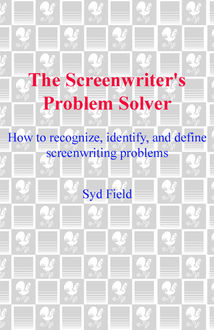
en
Dapatkan aplikasi:
iOS
·Android
The Screenwriter's Problem Solver
- Tentang
- Kutipan78
- Pembaca11
- Di rak buku
Buku ini saat ini tidak tersedia
332 halaman cetak
Kutipan
- Людмила Рудневаmembuat kutipan4 tahun yang laluThere are symptoms that can be identified if you know what to look for, and they usually give a pretty good indication of what the problem is, whether the script is slow and heavy, or too long, or all the characters sound the same. If that’s the case, then how do you fix it, or shape it, transform it from a “bad read” into a “good read”?
For example, if your dramatic premise seems weak and not clearly articulated and defined within the first ten pages, then the chances are that the Set-Up is weak and the material is going to wander around in different directions and lack a dramatic focus. That’s a symptom; let it go on too long and you’ve got a dull screenplay; just as a scratchy irritation in the throat is sometimes the symptom of a cold or flu. Symptoms reveal things, and in the “art” of medicine, if you read the symptoms correctly, then you can find the cause, and heal the disease, whatever it might be. At least, in theory.
In screenwriting you cure the problem by knowing and understanding its symptoms. For example, suppose a writer wants to create a strong action line and, in so doing, sets up the story so fast, he or she simply skims over, or omits, necessary and essential character information? It won’t take the writer long to realize the character’s been sacrificed for action.
We can identify this because the character will be so busy reacting to the events or the situation that we don’t have an opportunity to learn anything about him or her. That’s a symptom. And it always seems to lead to a dull and boring read. When I see a script unfolding like this, with the character simply reacting to his or her situation, I’ll give the writer thirty pages to see whether it works or not. If it doesn’t, I’ll stop read - Людмила Рудневаmembuat kutipan4 tahun yang laluIf you wanted to examine “the stuff” that makes dull writing, what would you say? What is the nature of dull? What does it look like? What does it taste like, and what is its essence, the seed that sprouts into the tree?
- Людмила Рудневаmembuat kutipan4 tahun yang lalustory, through the characters and events, is one of those simple, basic “truths” of all writing, whether it be novel, play, or screenplay.
In my seminars and workshops, no matter what the language or culture, I find that many screenwriters do not understand the importance of conflict in their stories. And their screenplays reflect that. So many times the characters seem listless, the scenes slow, taking too much time to develop; there is little or no direction, and it boils down to a screenplay that is dull and boring to read.
So what is conflict? If you look at the word it means to be “in opposition”; and the hub of any dramatic scene is having the character or characters be in opposition to someone, or something. Conflict can be anything, a struggle or a quarrel, a battle or a chase scene, internal or external, any kind of confrontation or obstacle, and it really doesn’t matter whether it’s emotional, physical, or mental.
Conflict must be at the very hub of your story, because it is the core of strong action and strong character. If
fb2epub
Seret dan letakkan file Anda
(maksimal 5 sekaligus)

